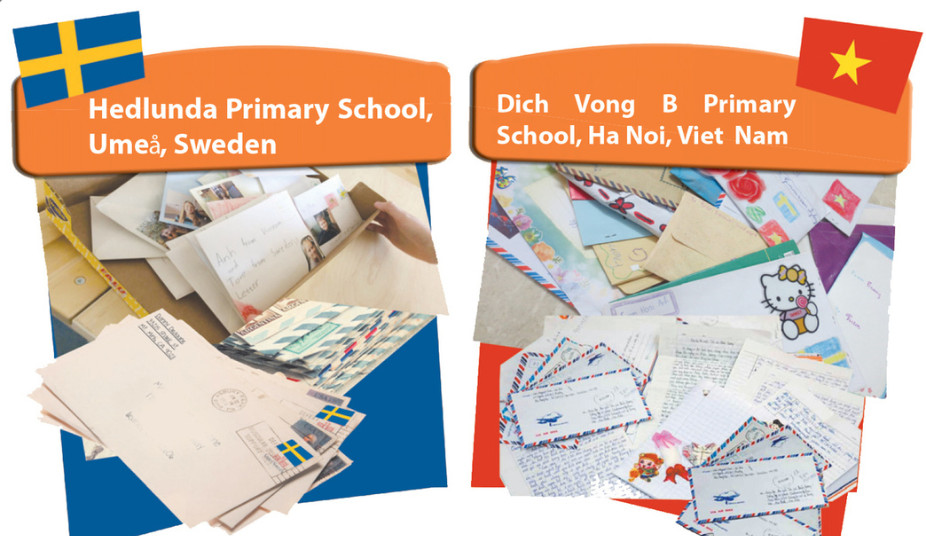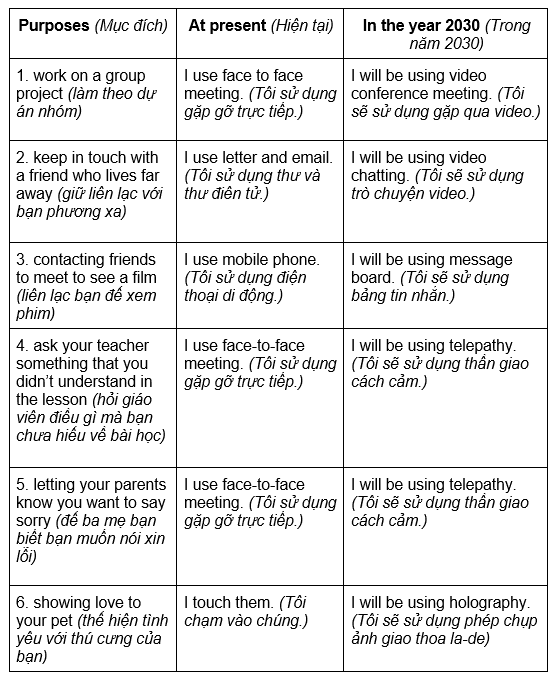Để giúp các em tìm hiểu về nhiều cách giao tiếp khác nhau, mời các em tham khảo bài học Unit 10 "Communication" Tiếng Anh lớp 8 mới phần Skills 1.
Tóm tắt lý thuyết
1.1. Task 1 Unit 10 lớp 8 Skills 1
Look at the letters the children from Viet Nam and Sweden sent to each other in a penfriend project. Why do you think they chose this way to communicate with each other? (Nhìn vào những lá thư mà trẻ em từ Việt Nam và Thụy Điển gửi cho nhau trong dự án bạn qua thư. Tại sao em nghĩ họ chọn cách này để giao tiếp với nhau)

Guide to answer
I think this method can present love more sincerely. (Tôi nghĩ phương pháp này có thể thể hiện tình cảm chân thành hơn.)
1.2. Task 2 Unit 10 lớp 8 Skills 1
Read the text. (Đọc bài văn.)
COMMUNICATION IN THE FUTURE: WHAT IS THERE FOR US?
About fifty students in two schools in Ha Noi, Viet Nam and Umea, Sweden have been exchanging letters in a penfriend project since 2013. ‘I love to write. You can even stick something on the letter, like this tiny sweet!’ said Linh, from Ha Noi about the project. From the Sweden end, Anders said, ‘It’s so nice to open and read real letters!’ But will this be our future communication? It’s said that in a couple of decades we’ll be using telepathy and holography.
Telepathy uses a tiny device placed into our head. Information will be sent and received directly to and from our brains. We’ll be communicating just by thought over the network! Holography, a video-conference technology with three-dimensional images, will help us interact in real time in completely different places.
Impressed? Maybe, but not everyone thinks the cyberworld will replace the real world. Like the children in the penfriend project, I prefer to chat with my friends over a cup of tea and enjoy their company - life is more meaningful that way!
Look at the highlighted words and match them with their meanings. (Nhìn vào từ được tô và nối chúng với ý nghĩa.)
Guide to answer
1. immediately, without delay - in the real time (ngay lập tức, không hề trì hoãn)
2. to communicate with or react to - interact (giao tiếp với hoặc phản ứng với nhau)
3. the opposite of a flat image - three-dimentional images (trái với hình ảnh phẳng)
4. the digital world - cyberworld (thế giới số)
5. a system of connected parts to share information - network (một hệ thống gồm những phần liên kết để chia sẻ thông tin)
Tạm dịch:
GIAO TIẾP TRONG TƯƠNG LAI: CÓ GÌ CHO CHÚNG TA?
Khoảng 50 học sinh từ 2 trường ở Hà Nội, Việt Nam và Umea, Thụy Điển đã và đang trao đổi thư từ trong dự án bạn qua thư từ năm 2013. “Mình thích viết. Bạn thậm chí có thể dán thứ gì đó vào thư, như viên kẹo nhỏ này” Linh, từ Hà Nội, nói về dự án. Từ cuối của Thụy Điển, Anders nói, “Thật tuyệt khi mở và đọc thư thật!". Nhưng liệu đây có phải là cách giao tiếp trong tương lai của chúng ta không? Người ta nói rằng trong một vài thập kỷ, chúng ta sẽ sử dụng thần giao cách cảm và phép chụp ảnh giao thoa la-de.
Thần giao cách cảm sử dụng một thiết bị nhỏ đặt vào đầu chúng ta. Thông tin sẽ được gửi và nhận trực tiếp đến và từ bộ não của chúng ta. Chúng ta sẽ giao tiếp chỉ bằng suy nghĩ qua mạng! Phép chụp ảnh giao thoa la-de, một công nghệ hội nghị truyền hình với hình ảnh ba chiều, sẽ giúp chúng ta tương tác trong thời gian thực ở những nơi hoàn toàn khác nhau.
Ấn tượng không? Có thể, nhưng không phải ai cũng nghĩ rằng thế giới mạng sẽ thay thế thế giới thực. Giống như những đứa trẻ trong dự án bạn qua thư, tôi thích trò chuyện với bạn bè của mình bên tách trà và tận hưởng cuộc sống cùng họ - cuộc sống có ý nghĩa hơn theo cách đó!
1.3. Task 3 Unit 10 lớp 8 Skills 1
Answer the following questions. (Trả lời những câu hỏi sau)
1. What do the students like about the penfriend project? (Những học sinh thích gì về dự án bạn qua thư?)
2. What are the two ways of future communication mentioned in the text? Explain how they work?
(Hai cách giao tiếp trong tương lai được đề cập trong bài văn là gì?Giải thích cách chúng hoạt động?)
3. Do you think the writer is happy with this future of communication? How do you know?
(Bạn có nghĩ người viết vui với cách giao tiếp tương lai này không? Bạn nghĩ sao?)
Guide to answer
1. They love to write and read real letters/ one student likes to send sweets with the letters as well.
(Họ thích viết và đọc thư. Một học sinh còn gửi kẹo kèm theo thư nữa.)
2. They are telepathy and holography. One student uses a tiny device our head to communicate by thought over the network. Holograp gives three-dimensional images and we will be able to interact with each other in real time.
(Chúng là thần giao cách cảm và phép chụp ảnh giao thoa la-de. Thần giao cách cảm sử dụng một thiết bị nhỏ trong đầu chúng ta để giao tiếp bằng suy nghĩ qua mạng. Phép ghi ảnh toàn cảnh sẽ có thể tương tác với nhau trong thời điểm thật.)
3. She prefers to use real, face-to-face communication because she thinks this makes life more interesting.
(Cô ấy thích giao tiếp thật, trực diện hơn. Bởi vì cô ấy nghĩ điều này làm cho cuộc sống thêm thú vị.)
1.4. Task 4 Unit 10 lớp 8 Skills 1
In small groups, decide whether you agree with the author of this text. Why/ why not? Share your ideas with the class. (Trong những nhóm nhỏ, quyết định rằng em có đồng ý với tác giả của bài viết không. Tại sao có, tại sao không?)

Guide to answer
I absolutely agree with the author. Writing letter and F2F meeting is much happier and sticks people closer. Technology may develop and change the ways we communicate, but the real spirit life will be still unchanged, so meeting directly is much more meaningful. (Tôi hoàn toàn đồng ý với tác giả. Viết thư và gặp mặt thì vui hơn và gắn kết mọi người lại gần nhau hơn. Công nghệ phát triển và thay đổi cách chúng ta giao tiếp, nhưng đời sống tinh thần thực tế sẽ không đổi, vì vậy gặp trực tiếp thì có ý nghĩa hơn nhiều.)
1.5. Task 5 Unit 10 lớp 8 Skills 1
Class survey. What ways of communication do you use for the following purposes now and what will they be in the year 2030? (Khảo sát lớp. Cách nào giao tiếp mà em sử dụng cho những mục đích sau và chúng sẽ là gì trong năm 2030?)
Guide to answer

Bài tập trắc nghiệm Skills 1 Unit 10 lớp 8 mới
Như vậy là các em đã xem qua bài học phần Unit 10 Communication- Skills 1 chương trình Tiếng Anh lớp 8 mới. Để củng cố kiến thức bài học mời các em tham gia bài tập trắc nghiệm Trắc nghiệm Unit 10 lớp 8 mới Skills 1.
-
Câu 1: Read the passages below and choose the best tittle for each passage?
1. __________ Millie is 14 years old and lives in Miami. She has 204 friends – and she makes two or three more friends every week. About 20 of her friends also live in Miami. Some go to the same school, and others go to the same music clubs and sports centers. She often sees them. The others live in other cities and other countries: England, Canada, Japan … She never meets these friends, but she talks to them on the Internet. They are her “My Space Friends”.
2. __________ Because of websites like MySpace, Yahoo 360 and Bebo, people can make friends online. These websites are very popular all over the world, especially with young people. Users have their own homepage. They give information about themselves. They write letters for their webpage, show photos and give opinions. They write about their favourite films, music and TV programmes.
3. __________ For many young people, a good homepage is an important part of their image. It says: “This is me! I have something to say. These things – and these people – are important in my life.” And these websites are also an easy way to talk to a lot of different people. That is why teenagers likes these “friends” websites.
4. __________ But some people are worried that these websites aren’t safe. For example, it is impossible to know that the information on a homepage is true. Perhaps the 14-year-old girl you talk to online is really a 40-year-old man.
5.__________ So here is some advice. Keep your webpage private. (only friends can see a private homepage). Do not put photos of yourself on your homepage. Do not meet people that you only know because of the website. And finally, remember that online friends are fun, but they are not the same as real friends.
SUGGESTED TITTLES:
Tittle 1 – Why do “friends” websites seem dangerous?
Tittle 2 – How do “friends” websites work?
Tittle 3 - What’s the best advice for people who want to use “friends” websites?
Tittle 4 – Where do Millie’s friends live?
Tittle 5 – How can I find “friends” websites?
Tittle 6 – Why are “friends” websites popular?
Paragraph 1: ...................
- A. Tittle 1
- B. Tittle 3
- C. Tittle 4
- D. Tittle 6
-
- A. Tittle 5
- B. Tittle 2
- C. Tittle 3
- D. Tittle 1
-
- A. Tittle 2
- B. Tittle 4
- C. Tittle 6
- D. Tittle 3
Câu 4-10: Mời các em đăng nhập xem tiếp nội dung và thi thử Online để củng cố kiến thức về bài học này nhé!
Lời kết
Kết thúc bài học này các em cần luyện tập đọc hiểu về dự án bạn qua thư, tập nói về các cách giao tiếp trong tương lai; đồng thời ghi nhớ các từ vựng sau:
- exchanging letter: trao đổi thư
- a couple of: một vài
- decade (n): thập kỉ
- tiny device: thiết bị nhỏ
- directly (adv): trực tiếp
- three-dimensional images: hình ảnh 3 chiều
- interact (v): tương tác
- impressed (adj): bị ấn tượng
- cyberworld (n): thế giới số
- replace (v): thay thế
- company (n): việc ở bên cạnh ai đó, người mà bạn ở cùng
Hỏi đáp
Trong quá trình học tập nếu có thắc mắc hay cần trợ giúp gì thì các em hãy comment ở mục Hỏi đáp, Cộng đồng Tiếng Anh HOC247 sẽ hỗ trợ cho các em một cách nhanh chóng!
Chúc các em học tập tốt và luôn đạt thành tích cao trong học tập!













